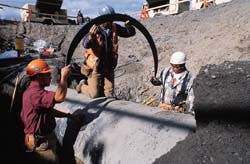J. David Norton, Wes Tonkins, Bill Flanders
Alyeska Pipeline Service Co.
Anchorage
Workers measure a section of TAPS for ovality. (Photograph courtesy of Alyeska Pipeline Service Co., Anchorage; copyright David A. Predeger, Anchorage)
- Excavation of a TAPS section to remove bedrock outcropping and pipeline insulation is carried out in preparation for inspection of the segment. (Photograph courtesy of Alyeska Pipeline Service Co., Anchorage; copyright David A. Predeger, Anchorage [16,063 bytes])
- Welders work to reinforce a repair sleeve over a dent in a section of TAPS. (Photograph courtesy of Alyeska Pipeline Service Co., Anchorage; copyright David A. Predeger, Anchorage [10,319 bytes])
The vibrations only occurred when the slackline-packline interface was positioned in a terraced portion of the pipeline topography downstream of the pass. This knowledge allowed Alyeska to control the pulsations by backpressuring the pipeline and moving the slackline-packline interface above the terrace.
The vibrations could on occasion be detected by residents living beside the pipeline at the base of the pass and led to concerns about long-term metal fatigue for the pipeline.
Slackline is a pipeline flow condition in which the oil stream does not completely fill the pipe cross-section. Slackline-flow conditions are used as an alternative to pressure-reducing stations to reduce head pressure from high static elevations.
Slackline is usually used in steep grades from high elevations where the hydraulic head gradient follows the pipeline elevation profile.1
Early indications
The Trans Alaska Pipeline travels 800 miles from Prudhoe Bay to the ice-free terminal at Port Valdez (Fig. 1 [ 105,328 bytes]). Thompson Pass, 25 miles north of Valdez, is part of the Chugach mountain range, the most southerly of the three mountain ranges the pipeline crosses.TAPS has delivered more than 12 billion bbl of oil since start-up in 1977. Throughput peaked in 1988 at an average of 2.1 million b/d. In 1996, throughput averaged 1.4 million b/d.
A slackline condition has existed at Thompson Pass since start-up of the pipeline in 1977. In 1996, however, lower throughput rates related to decline in North Slope production created a slackline condition that resulted in pipeline vibrations near the interface where slackline merges back into normal, or packline, flow.
The lower flow rates in 1996 resulted in the slackline-packline interface point moving downslope to an area in Thompson Pass that generated a more dynamic merging of flow conditions. As the vapor in the slackline section collapsed into liquid flow in the packline section, pressure pulses were generated.
These pulses in the downstream flow generated by the vapor-bubble collapse resulted in ground vibrations felt by homeowners near the base of the pass.
Alyeska responded to resolve any concern about the long-term effect of vibrations on pipeline integrity.
Steps that were taken included managing pipeline throughput rates to minimize vibrations, installing equipment to control vibrations by use of pipeline backpressure, increasing monitoring of critical sites for hydrocarbon releases, conducting an inspection and repair program to address pipeline fatigue issues, and assessing other slackline sections of the pipeline for vibration problems.
A field investigation and testing program was initiated at Thompson Pass to assess the nature of the vibration.2 A detailed pipeline-integrity analysis was performed on the Thompson Pass piping to determine the effect of vibration on the pipeline. While immediate integrity concern was low, the vibrations caused concern that the long-term integrity of the pipeline could be compromised by metal fatigue.
Interfacial dynamics
The vibrations were reported to Alyeska by local residents in August 1996. In September 1996, Alyeska conducted flow tests to determine the range of the problem and to verify potential solutions.The testing determined that when the pressure (or backpressure) of the oil flow was increased as it comes into the Valdez marine terminal, the packline section of oil moved further up the Thompson Pass slope. This reduced the length of the slackline section and smoothed the turbulent flow where the slackline flow merged with the packline flow (interface; Fig. 2 [336,636 bytes]).
The vibrations were characterized by a wide range of frequencies and amplitudes. The mean pulses were on the order of 60 psi about every 4 sec, and peak pulses were about 110 psi.
The field investigations indicated that these vibrations were the result of dynamics of slackline-packline interface and the collapse of vapor pockets generated by turbulence at the slackline-packline interface. This phenomenon also appeared to be sensitive to pipeline profile where the interface is close to a pipe-profile grade change.
The recommended solution to this problem was to increase backpressure to move the slackline transition interface to a smoother, steeper area upstream and also to reduce the length of the slackline section.
The vapor pockets collapse as they travel into higher-pressure regions of the packed line. Contributing to the intensity of the pipe vibrations was the amount of fluid between the slackline-packline interface and the collapsing vapor pockets. As the length and elevation change in a slackline region increases, there is a greater likelihood of entering a slug-flow regime.
Slug flow and the greater turbulence generated by large vertical drops can carry vapor pockets further downstream before they collapse. When the turbulent zone is in a steep section of pipe, the buoyant force of the vapor pockets causes them to flow back up the pipe, preventing them from getting carried very far into the packline sections before they collapse.
When the vapor pockets enter a relatively flat section of the pipe downstream of the interface, however, such as occurs at Thompson Pass at lower flow rates (Fig. 3[176,090 bytes]), the buoyant forces do not carry the vapor pockets upstream; they are carried further downstream before they collapse.
In this situation, there is a much longer column of oil between the slackline-packline interface and the collapsing vapor pocket. When this longer column of oil rushes in to fill the void created by the collapsing vapor, the increased mass causes a much higher pressure pulse.
The further downstream the vapor pocket travels and the larger the vapor pocket grows before collapsing, the higher the pressure pulse.
The pressure pulses are transmitted down the line. When a pulse passes a bend, it causes a lateral impulsive load, which in turn causes vibrations. If the pipe does not move much, this energy is transmitted directly to the ground as ground vibrations.
The vapor-bubble collapse appeared to be more energetic when the packline interface was at a terrace midway in the Thompson Pass slope (Fig. 2). Pipeline profile was therefore a key component of the occurrence of the phenomenon (Fig. 3).
A crude-composition study was performed to determine if higher levels of NGLs in the crude stream contribute to the magnitude or frequency of vapor-bubble collapse. Laboratory testing determined that NGL content did not significantly contribute to the vibration.
Backpressure control
Alyeska consulted with other pipelines with significant slackline (Trans Alpine Pipeline, Germany; Interprovincial Pipeline, Canada; and BP Colombia) to discuss similar issues and potential solutions. Alternatives considered were:- Install backpressure-regulation system (preferred solution)
- Purchase affected properties as buffer
- Install nitrogen accumulators and standpipe at Thompson Pass
- Install pressure regulation at remote gate valves
- Install nitrogen injection into pipeline
- Revise composition of crude-oil stream
- Reroute pipeline to eliminate steep slopes and terraces
- Maintain throughput at higher levels.
Alyeska began controlling slackline pulses in December 1996 with a variety of pipeline flow management and backpressure-control procedures. These steps essentially eliminated the pulses and stopped fatigue damage from accumulating.
The backpressure system is an arrangement of control valves and piping that increases pipeline pressures between Valdez and Thompson Pass. The control valves choke flow, thereby increasing pressures in the pipeline. The increased pressures raise the slackline-packline interface at Thompson Pass to an elevation that will eliminate pipeline pressure pulses and resulting ground vibrations.
A permanent backpressure-control system was completed in September 1997. The schedule for permanent facilities was driven by long delivery dates for piping and valves, but pressure-pulse elimination was desired immediately to minimize further fatigue-damage accumulation at several pipeline areas of concern near Thompson Pass.
A temporary arrangement of valves and control procedures was put in place in January 1997.
Until the temporary system was operational, and during periods when backpressure control was not in service, a strategy of throughput management was utilized to maintain flow at rates sufficiently high to minimize pressure pulses. This strategy was useful to minimize throughput rates that cause pressure pulses, but the temporary backpressure system eliminated pressure pulses without regard to throughput rates.
In order to eliminate the slackline vibrations during this temporary backpressure control, the slackline-packline interface was maintained at the 1,850-ft elevation at Thompson Pass (Fig. 2). Based on field tests conducted in September 1996, the interface at this elevation substantially reduced pressure pulses. Keeping the interface at this elevation requires maintaining sufficient backpressure at the terminal and varying the required backpressure as a function of pipeline throughput.
To operate in temporary backpressure mode, four existing 16-in. Fisher relief valves were replaced with four 16-in. Introl valves (ABB Kent Introl Ltd., West Yorkshire, U.K.) that were moved from out-of-service systems at pipeline pump stations. The Introl valves are better suited for flow control than the Fisher valves.
Two of the Introl valves were used for backpressure control, and two were used for pressure safety relief. At current throughput rates, only one valve was required for relief service, with an additional valve as standby spare.
During this mode of operation, the terminal incoming meters were bypassed. Leak detection was maintained by use of a temporary flow meter installed on the incoming crude line.
The permanent backpressure-control system is more functional than the temporary system and allows the terminal to operate under normal procedures for metering, tank-farm use, and line pigging.
It consists of a bypass piping arrangement that uses five 12-in. Introl valves for backpressure control and four 16-in. Introl valves for pressure relief. All flow goes through the existing meters for line balancing.
Integrity analysis, modeling
A pipeline-integrity analysis of the effect of slackline pulsations on the pipe was completed in January 1997 with computer models of the pipeline. 3 The analysis concluded that fatigue damage to the pipe from repeated pressure pulses was not an immediate threat to the pipeline.Both "global" and "local" analyses were performed.
The global analysis addressed the effect of traveling pressure pulses on pipe bends to determine if pipe deflections were large enough to cause unacceptable stresses in the pipe or local damage to the surrounding soil support.
The global effect was assessed by simulating a pressure pulse traveling along the pipeline. The AutoPIPE pipe-stress computer program was used to conduct time history analyses of the traveling pulses.4 The analyses showed that the stresses and pipe deflections were small and did not affect pipe integrity or soil support for round pipe.
The local analysis addressed the effect of radial deformation or "rerounding" of the pipe at locations where the pipe is ovaled or dented. The assessment used the FACTS analysis program to conduct a structural analysis of a finite-element model of the buried pipeline, accounting for properties of both the pipe and supporting soil.5
The rerounding causes the pipe wall to flex and as a result of the frequency of pulses, the pipe could experience fatigue damage over time. If rerounding of the pipe occurs at a girth-weld location, flexing of the pipe wall could cause propagation of existing flaws in the weld.
In addition, some areas of the pipeline have been sleeved for corrosion or mechanical damage. Some of these sleeves have a fillet weld connecting the sleeve to the carrier pipe. The differential radial expansion of the sleeved and unsleeved pipe can stress the fillet weld, possibly causing growth of weld flaws.
Input parameters for the local analysis required a high level of detail in the modeling of the pipe condition. Alyeska maintains a state-of-the-art pipeline monitoring program that includes annual inspections of the pipe with intelligent pigs. In addition, construction specifications required 100% radiography of girth welds.
The radiographs have been archived for use in integrity and fitness-for-service analyses. Pipe-condition data are maintained in a data base that allows very accurate modeling of the pipeline for the integrity and fatigue analysis. Ovaled pipe and dent-feature locations were identified with this data base for the local analysis.
To develop a family of fatigue curves (stresses vs. cycles, or SN), preprocessing analysis required assigning the very large pressure data set into "bins" to categorize the frequency and amplitude of a wide range of pressure pulses. The pressure pulse distribution had log-normal statistical form.6
A fatigue-damage ratio using Miner's Rule was used as a measure of fatigue damage. The American Welding Society (AWS) A-curve was used to determine the number of cycles to failure at various stress levels.
Two S-N curves were developed: a "design" curve, which indicates whether the pipe at a local area of concern would satisfy the criteria for new pipeline design, and a "decision" curve, which is less conservative than the design curve and is better suited for deciding appropriate interventions and actions in the short term.
The area of most concern was determined to be an ovaled and dented section of pipe near the location of highest pressure pulses at pipeline Milepost (MP) 776. The analysis suggested that with the pressure pulses stopped, the pipe has an effective remaining design life, from a metal fatigue standpoint, of 63 years at this location.
If the pressure pulses had not been stopped and continued at 1996 levels, the effective remaining fatigue design life would have been about 3 years. Flaw-crack growth at girth welds and at sleeve fillet welds was considered improbable at the stress levels analyzed.
A technical peer review by the Joint Pipeline Office, a joint federal/state oversight agency, confirmed the analysis performed by Alyeska and supports Alyeska's conclusions.
Excavation, inspection
Although the pipe was deemed to be stable and safe from the integrity analysis, Alyeska committed to an inspection of the ovaled and dented area at pipeline MP 776 to verify the computer analysis and to confirm, by testing, some of the key assumptions made in the computer model about pipe support and geometry.The site was excavated in July 1997. The excavation also allowed investigation of the cause of two dented areas and to make any repairs deemed necessary.
Leak detection and environmental monitoring equipment was installed at the area of concern in November 1996 and continued to operate until the pipe excavation commenced. No hydrocarbon release was detected except for abnormal readings recorded in November 1996, which resulted in a contingency response and subsequent determination that the elevated readings presented a false alarm. No evidence of an old spill or leak was found during the excavation in July 1997.
The pipe was found to be resting on bedrock in two areas. This apparently was the cause of the dents. The rock was removed by hand and jackhammer to provide at least 18 in. of clearance for pipe inspection and reapplication of epoxy coating for corrosion protection.
Pressure in the line at the dig site was increased from approximately 150 psi to approximately 450 psi during the excavation to reduce vibrations and facilitate rerounding of the ovaled and dented areas. The pipe is rated to be operated at 901 psi.
No evidence of fatigue damage or cracking was found. This area was considered the governing area of concern, but no fatigue damage was expected, based on effective remaining life forecasts from the computer models.
The pipe was examined by wet fluorescent magnetic particle methods that could reveal microcracks on the outside surface of the pipe and also by nondestructive ultrasonic methods that examine the interior of the pipe wall for crack features.
As part of standard pipe inspection procedures, a visual exam of the pipe revealed a corrosion feature that may have originated as a scratch or groove in one of the dented areas. The feature is approximately 3.5 in. long, 0.5 in. wide with a maximum depth of 0.04 in. or about 9% of the pipe wall thickness.
Preliminary calculations indicated that this feature would not jeopardize the pipeline if not repaired. ASME B31.4 code, however, requires repair of such features. Consequently, Alyeska installed a 30-in. long pipe sleeve over the area before the pipe was reburied.
Other slackline areas
Other potential and future slackline areas of the pipeline were analyzed for potential pressure pulses. 7 No conditions similar to those at Thompson Pass that contribute to pulsation generation were detected.A testing program similar to the Thompson Pass investigation was performed for other slackline areas with some potential for a similar phenomenon. During the tests, the pipeline was operated through a range of flow rates designed to generate pulsations if possible.
No significant deviations were detected. Slackline areas tested include Keystone Canyon, Atigun Pass, MP 320, and Finger Mountain. Testing of other lower-priority areas at Isabel Pass, Huffman's, Cascaden Ridge, and Wilbur Ridge was considered unnecessary.
The testing and analysis of other slackline areas concluded that conditions that contributed to vibrations include slackline elevation changes of 500 ft or more, and a pipeline geometry of steep slopes and intermediate grade changes or terraces.
Acknowledgments
The authors would like to acknowledge the support for publication of this article from Norman Ingram, Jennifer Ruys, Tracy Green, and Stephanie Bellinger, all of Alyeska Pipeline Service Co., along with the contribution of technical experts who worked on the project: Jim Maple, J.A. Maple & Associates; Jim Hart, SSD Consultants; Glen Stevick, BEAR Inc.; and Bucky Tart, Golder Associates.References
- Burnett, R.R., "Predicting unbalanced forces in liquid lines can avert damage," OGJ, Mar. 27, 1995, p. 35.
- Baskurt, et al., "Slackline Testing of the Trans-Alaska Pipeline System at Thompson Pass," to be presented to the International Pipeline Conference, Calgary, June 7-11, 1998.
- Hart, et al., "Fatigue Damage Calculations for a Dented and Ovaled Section of the Trans-Alaska Pipeline System at Thompson Pass," to be presented to the International Pipeline Conference, Calgary, June 7-11, 1998.
- Rebis Inc., "AutoPIPE Pipe Stress Analysis and Design Program," Walnut Creek, Calif., 1995.
- SSD Engineering Consultants Inc., "FACTS: Finite Element Analysis of Complex Three-Dimensional Systems," 1991.
- Stevick, et al., "Fatigue Curves for Damage Calculations for a Dented and Ovaled Section of the Trans-Alaska Pipeline System," to be presented to the International Pipeline Conference, Calgary, June 7-11, 1998.
- Tonkins, et al., "Trans-Alaska Pipeline System Linewide Slackline Investigations for Potential Pipe Vibrations," to be presented to the International Pipeline Conference, Calgary, June 7-11, 1998.
The Authors
Copyright 1998 Oil & Gas Journal. All Rights Reserved.





